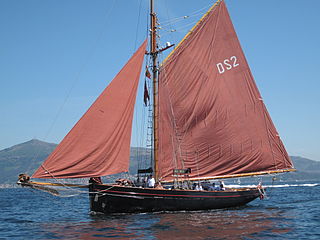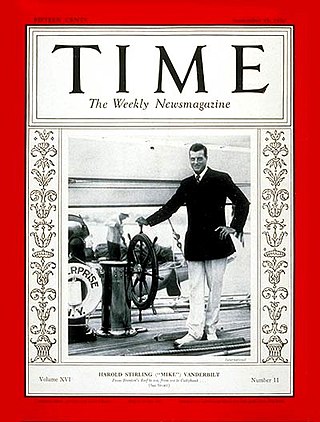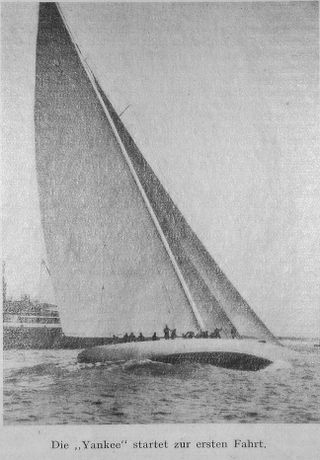Related Research Articles

Jolie Brise is a gaff-rigged pilot cutter built and launched by the Albert Paumelle Yard in Le Havre in 1913 to a design by Alexandre Pâris. After a short career as a pilot boat, owing to steam replacing sail, she became a fishing boat, a racing yacht and a sail training vessel.

Harold Stirling Vanderbilt CBE was an American railroad executive, a champion yachtsman, an innovator and champion player of contract bridge, and a member of the Vanderbilt family.

The New York Yacht Club (NYYC) is a private social club and yacht club based in New York City and Newport, Rhode Island. It was founded in 1844 by nine prominent sportsmen. The members have contributed to the sport of yachting and yacht design. As of 2001, the organization was reported to have about 3,000 members. Membership in the club is by invitation only. Its officers include a commodore, vice-commodore, rear-commodore, secretary and treasurer.

The J Class of racing yachts were built to the specifications of Nathanael Herreshoff's Universal Rule. The J Class is considered the apex of the era when the Universal Rule determined eligibility in the America's Cup.

John Pierpont Morgan Jr. was an American banker, and finance executive. He inherited the family fortune and took over the business interests including J.P. Morgan & Co. after his father J. P. Morgan died in 1913.

Columbia was an American racing yacht built in 1899 for the America's Cup races. She was the defender of the tenth America's Cup race that same year against British challenger Shamrock as well as the defender of the eleventh America's Cup race in 1901 against British challenger Shamrock II. She was the first vessel to win the trophy twice in a row

His Majesty's Yacht Britannia was a gaff-rigged cutter built in 1893 for RYS Commodore Albert Edward, Prince of Wales. She served both himself and his son King George V with a long racing career.
The 2nd Louis Vuitton Cup was held in Fremantle, Western Australia in 1987. The winner, Stars & Stripes, went on to challenge for and win the 1987 America's Cup.
The 1987 Defender Selection Series was raced between four syndicates competing for the right to represent the Royal Perth Yacht Club as the defender of the America's Cup. Kookaburra III won the series and advanced to the 1987 America's Cup. However, they failed to defend the cup from the challenge of Stars & Stripes 87.

Endeavour is a J-class yacht built for the 1934 America's Cup by Camper and Nicholson in Gosport, England. She was built for Thomas Sopwith who used his aviation design expertise to ensure the yacht was the most advanced of its day with a steel hull and mast. She was 130-foot (40 m) and launched in 1934 and won many races in her first season including against the J's Velsheda and Shamrock V. She failed in her America's Cup challenge against the American defender Rainbow but came closer to lifting the cup than any other until Australia II succeeded in 1983.
Roderick Stephens, Jr. was one of America's best known and respected sailors. In 1933 he became Associate Designer, later promoted to President, of Sparkman & Stephens naval architecture and yacht design firm, a company founded in 1929 by his brother Olin Stephens and Drake Sparkman.

Shamrock V is a British J-class yacht. She was the first British yacht to be built to the new J-Class rule. She was commissioned by Sir Thomas Lipton for his fifth America's Cup challenge. Although refitted several times, Shamrock is the only original J-class never to have fallen into dereliction.
Enterprise was a 1930 yacht of the J Class and successful defender of the 1930 America's Cup for the New York Yacht Club. It was ordered by a syndicate headed by Vice-Commodore Winthrop Aldrich, designed by Starling Burgess, and built by Herreshoff Manufacturing Company.
Whirlwind was a 1930 yacht of the J Class built as a contender for the New York Yacht Club's defence of the 1930 America's Cup. She was ordered by a syndicate headed by Landon Ketchum Thorne, designed by Lewis Francis Herreshoff, and built by Lawley & Son. Whirlwind was unsuccessful in her bid to become the Cup defender, an honor that went to Enterprise. She never sailed again after the Cup races, and was scrapped in 1935.

Yankee was a 1930 yacht of the J Class built as a contender for the New York Yacht Club's defence of the 1930 America's Cup. She was ordered by a syndicate from the Eastern Yacht Club of Boston, organized by John Silsbee Lawrence, designed by Frank Cabot Paine, and built by Lawley & Son. Whirlwind was unsuccessful in her bid to become the Cup defender, an honor that went to Enterprise. With modifications, she took part in the trials for the 1934 America's Cup. She was eventually taken to the United Kingdom by a new owner in 1935 and was scrapped in 1941.
Camper and Nicholson is a yacht design and manufacturing company based in Gosport, England, for over two hundred years, constructing many significant vessels, such as Gipsy Moth IV and Prince Philip's yacht Bloodhound. Its customers included Thomas Sopwith, William Kissam Vanderbilt II and George Spencer-Churchill, 6th Duke of Marlborough. Its yachts competed in The America's Cup, The Fastnet Race, the Olympics, the Ocean Race and many other yacht races. It also built a number of small warships, notably during the two World Wars, and some as late as the 1950s.
The 1930 America's Cup was the 14th challenge for the Cup. It took place in Newport and consisted of a series of races between the defender Enterprise, entered by a syndicate of New York Yacht Club members headed by Winthrop Aldrich, and Shamrock V, the fifth in Sir Thomas Lipton's line of Cup challengers.
The 1934 America's Cup was the 15th challenge for the Cup. It took place in Newport and consisted of a series of races between the defender Rainbow, entered by a syndicate of New York Yacht Club members headed by Harold S. Vanderbilt, and Endeavour, owned by Sir Thomas Sopwith.
The 1937 America's Cup was the 16th challenge for the Cup. It took place in Newport and consisted of a series of races between the defender Ranger, entered Harold S. Vanderbilt, and Endeavour II, the second in Sir Thomas Sopwith's line of Cup challengers.
The America's Cup is the oldest international competition still operating in any sport.
References
- 1 2 3 4 Garland 1989, p.185
- 1 2 Dear 2004, p.50
- 1 2 3 4 5 6 Vanderbilt 1931, p.88
- 1 2 3 4 5 6 The National Iron & Steel Heritage Museum (n.d.)
- ↑ Vanderbilt 1931, p.4
- 1 2 3 Dear 2004, p.49
- ↑ Dear 2004, p.64
- ↑ Vanderbilt 1931, p.31
- 1 2 Vanderbilt 1931, p.89
- ↑ Vanderbilt 1931, pp.90–97
- ↑ Vanderbilt 1931, p.102
- ↑ Vanderbilt 1931, pp.104–07
- ↑ Vanderbilt 1931, p.103
- ↑ Vanderbilt 1931, p.107
- ↑ Vanderbilt 1931, p.108
- 1 2 Vanderbilt 1931, p.113
- 1 2 Vanderbilt 1931, p.135
- ↑ Vanderbilt 1931, pp.123,130
- ↑ Vanderbilt 1931, p.130
- 1 2 Vanderbilt 1931, pp.142–59
- ↑ Vanderbilt 1931, p.155
- ↑ Vanderbilt 1931, p.159
- ↑ Vanderbilt 1931, 161
- ↑ Vanderbilt 1931, 169
- ↑ Vanderbilt 1931, 183–84
- ↑ Vanderbilt 1931, pp.172–81
- ↑ Vanderbilt 1931, 172
- ↑ Vanderbilt 1931, 184–85
- ↑ Dear 2004, p.155
- ↑ "1929 - 1937 :: History :: J Class Association".